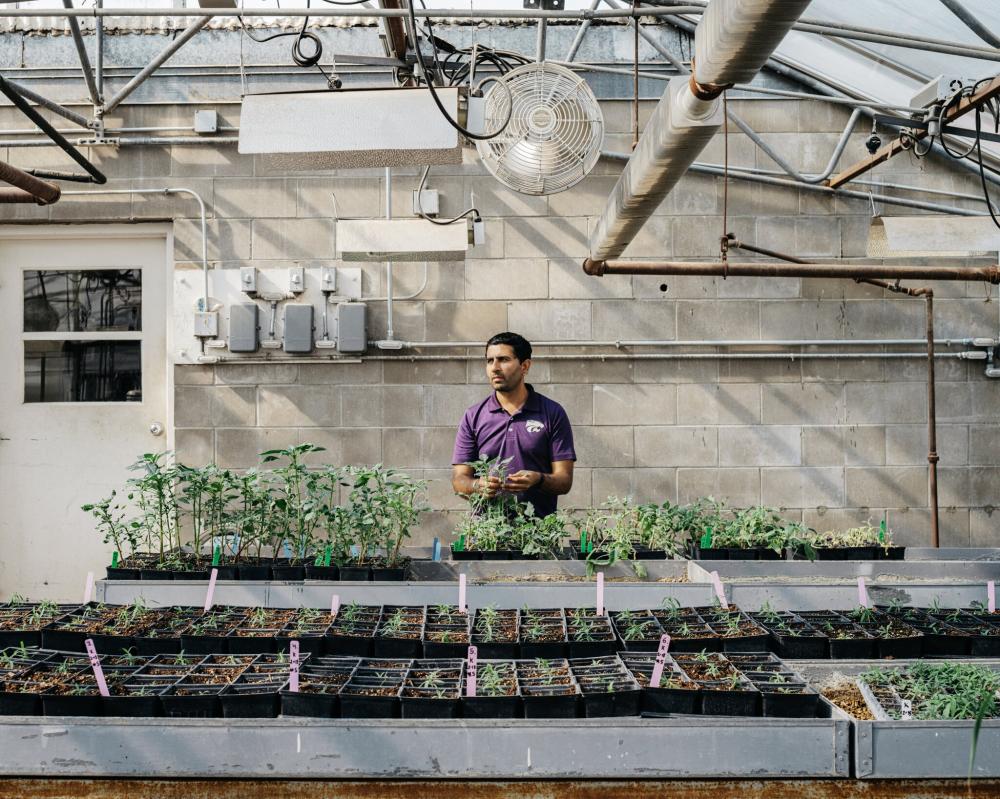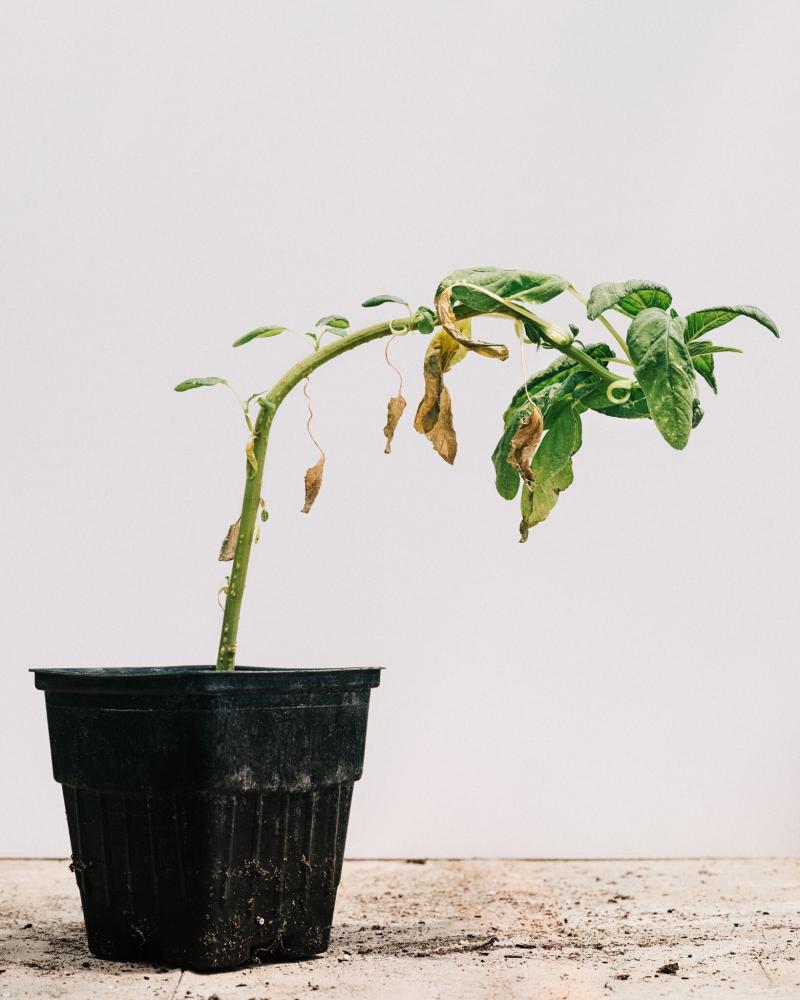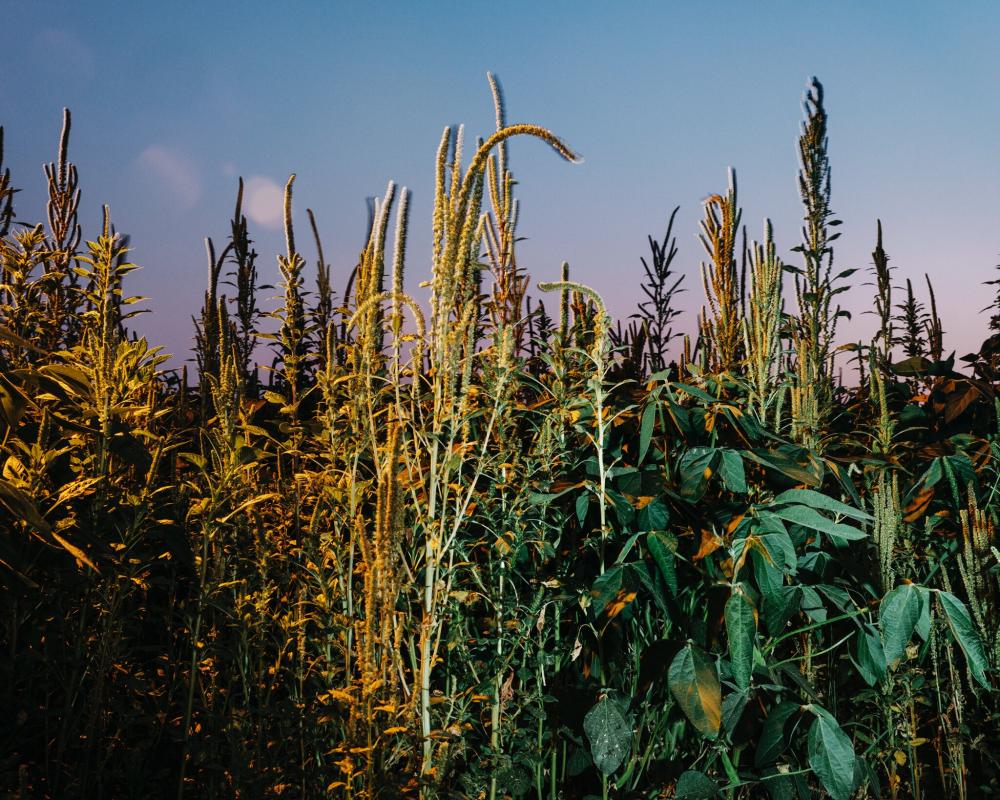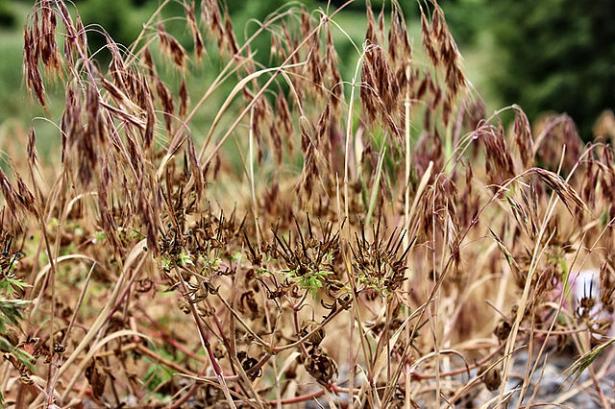It was already too late for Darren Nicolet to reverse course last June when he heard that the Ninth Circuit Court of Appeals had overturned E.P.A. approval of three products containing dicamba, a controversial but widely used weed killer. A farmer in Kansas, Nicolet had planned his season around the herbicide, planting his fields with soybeans that were genetically modified to survive being showered with the chemical. He was well aware of dicamba’s tendency to vaporize and drift from field to field, causing damage to crops and threatening nearby wildlife and trees, but he didn’t feel as if he had much of a choice: Dicamba was one of the last tools that provided some control over Palmer amaranth, an aggressive weed that would quickly go on to choke out his sorghum crop — and that threatened to overtake his soybeans too. “There was a little bit of a moment of panic there for a few hours,” Nicolet said; he was worried that a season without dicamba would mean devastation for his farm.
If there’s a plant perfectly suited to outcompete the farmers, researchers and chemical companies that collectively define industrial American agriculture, it’s Palmer amaranth. This pigweed (a catchall term that includes some plants in the amaranth family) can re-root itself after being yanked from the ground. It can grow three inches a day. And it has evolved resistance to many of the most common weed killers, continuing to reproduce in what ought to be the worst of circumstances: A three-day-old, herbicide-injured seedling, for example, can expend its last bit of energy to produce seeds before it withers up and dies. Unchecked, Palmer amaranth can suppress soybean yields by nearly 80 percent and corn yields by about 90 percent.
Nicolet was ultimately allowed to spray dicamba last summer because he purchased it before restrictions took effect. He used it this year too: The Trump administration issued new approvals for some formulations containing dicamba just a week before the presidential election. Still, Nicolet says the weed killer will eventually stop working on his land, another management tool rendered useless by the pigweed’s remarkable onslaught. Whether that day is 10 years in the future or three, he has no idea, but the Palmer amaranth continues to gain ground all the while. This summer, a handful of pigweeds sprouted in a field that had recently been sprayed. Nicolet couldn’t weed the 96 affected acres by hand, so he decided to let them grow. “It’s not really enough to hurt yield this year,” he said. “But you know, you have 100 weeds out there, the next year you’ll have a million.”
When I visited Nicolet’s farm, south of Great Bend, in July 2019, his soybeans were just a few weeks old. Already, Palmer amaranth plants outnumbered them, their narrow, rough-edged leaves intermittently flecked with purple, filling spaces between the rows and wedging themselves between the young soybean plants. I was tagging along with Vipan Kumar, a weed scientist from Kansas State University, and two of his graduate students as they checked in with local growers. Earlier, in the squat concrete greenhouse that functions as his research laboratory, Kumar held in front of me an arm-length seed pod on a top-heavy Palmer amaranth plant, one of many among rows and rows of tall, thin seedlings that shot up from small plastic trays designed to support just a few inches of growth, arcing past light fixtures and fans as they stretched toward the window-paneled ceiling. The plant in his hands was a Palmer amaranth descendant that had demonstrated resistance to 2,4-D, one of two active ingredients in compounds used to defoliate forests during the Vietnam War. Though this development was certainly bad news for farmers, Kumar seemed unable to suppress his awe for the plant’s evolutionary capabilities. “I was excited to see it,” he said, referring to the moment his team discovered the new resistance.

Vipan Kumar, a weed scientist from Kansas State University.Credit...Benjamin Rasmussen for The New York Times
At the farm, Nicolet, clad in faded jeans and a sweat-soaked baseball cap, bent down at a spot where the weeds looked brown and wilted. This field had been sprayed between plantings with an herbicide containing paraquat. A single sip of paraquat can kill a person, and the chemical was implicated in a string of random vending-machine poisonings carried out in Japan in 1985 that killed at least 10 people. “It’s something I don’t want to be around and something that I really don’t want to use,” Nicolet said. But sometimes the pigweed can appear to resurrect itself even after an application of paraquat: Nicolet recalled a recent instance in which the weeds appeared to die, only to start growing again a few days later. “I don’t know what the future will hold,” he said on a phone call later. “If things get worse enough, are we just going to be looking at basically just Palmer everywhere?”
Superweeds — that is, weeds that have evolved characteristics that make them more difficult to control as a result of repeatedly using the same management tactic — are rapidly overtaking American commodity farms, and Palmer amaranth is their king. Scientists have identified a population of Palmer amaranth that can tolerate being sprayed with six different herbicides (though not all at once), and they continue to discover new resistances. By now, it’s clear that weeds are evolving faster than companies are developing new weed killers: Just six years ago, in response to the onset of resistance to its marquee product, Roundup (active ingredient: glyphosate), Monsanto began selling a new generation of genetically modified seeds bred to resist both glyphosate and dicamba. By 2020, scientists had confirmed the existence of dicamba-resistant Palmer amaranth. The agribusiness giant took a decade to develop that product line. The weeds caught up in five years.
For a generation, Roundup worked as a one-size-fits-all approach to controlling weeds. But as resistant weeds spread, no better chemical was brought forward to succeed it. Instead, Monsanto placed its bets on an older weed killer, dicamba, that had problems with drifting. Glyphosate, too, has fallen out of favor outside U.S. farming circles because of its possible links to cancer, and Bayer, the company that acquired Monsanto in 2018, announced in July that it would phase the chemical out of U.S. lawn and garden products to avoid future lawsuits after committing up to $9.6 billion to settle about 125,000 claims that the product caused non-Hodgkin’s lymphoma among users. (Bayer stresses that this change is unrelated to safety considerations.) Glyphosate’s use remains ubiquitous among growers, however. Even though it doesn’t work on all weeds anymore, the alternative — adopting a more integrated approach to weed control — would mean totally rethinking their operations.
A January paper on a Palmer amaranth population shown to resist multiple weed killers put the problem succinctly: “Weed resistance to herbicides, especially multiple-herbicide resistance, poses a serious threat to global food production.” (Herbicide-resistant weeds are generally less of a concern on organic farms, but these make up less than 1 percent of total U.S. acreage.) It’s hard to estimate exactly how much damage has already been wrought by herbicide resistance; the weeds are gaining ground faster than scientists can survey them. But research published in 2016 by the Weed Science Society of America found that uncontrolled weeds could cause tens of billions of dollars of crop losses every year. Bob Hartzler, a retired weed scientist at Iowa State University, estimates that the tipping point when weed killers cease to be effective on some problematic species, including Palmer amaranth, is just five to 10 years away. “There’s general consensus among most weed scientists that the problems we see are just going to continue to accelerate,” he says. “And that’s why we’re sort of pessimistic that we can continue this herbicide-only system.”
In the arms race between biology and biotechnology, the weeds are winning. Worse, Kumar says, growers are clinging to the unrealistic idea that chemical companies will invent a miraculous new herbicide before it’s too late. Even if such a miracle product were close at hand, an even greater threat looms large: Evidence is mounting that weeds can actually metabolize herbicides, breaking them down before they do their work. In other words, Palmer amaranth may have evolved resistance to weed killers that have yet to be invented. “This is not something I just created in a lab,” Kumar says, referring to the onset of herbicide resistance. “It’s all there in nature, happening all over.”
Weeds always adapt to whatever’s trying to kill them. Lawn mowers exert evolutionary pressure on plants until they’re growing outward instead of upward, keeping close to the ground and avoiding the blade. Rice farmers weeding their paddies by hand skip over grasses that look like rice seedlings, allowing the imitators to reproduce — and making hand-weeding all the more difficult. Yet the speed and persistence with which herbicide-resistant weed populations have taken over American farmland is very much an outgrowth of the last few decades of industrial agriculture. Plants like Palmer amaranth evolved widespread resistance to Roundup precisely because it was ubiquitous.
When Monsanto introduced Roundup in the mid-1970s, it worked better than any other weed killer on the market, and it was dirt cheap as well. “It was so good,” Kumar says. “Wherever you put it, it was so effective.” “Top control at a rock-bottom price,” subsequent television ads would crow. “The herbicide that gets to the root of the problem.”
Two decades later, Roundup’s complement, an innovation that caused sales to surge even higher, arrived: Roundup Ready seeds. The genetically modified plants that sprouted from them could survive spray after spray of the herbicide. This enabled farmers to simply plant Roundup Ready seeds, wait until the weeds emerged, then spray the entire field with Roundup. Everything but the valuable crop quickly wilted and died. The development revolutionized weed control: Farmers no longer needed to buy a vast array of expensive herbicides each year or till their land every season.
Monsanto first rolled out Roundup Ready soybeans in 1996. Farmers rushed to adopt the paired products: By 2011, according to the Department of Agriculture’s Economic Research Service, about 94 percent of all soybean acres in the United States were planted with seeds engineered to resist herbicides. Cotton and corn followed similar trajectories. Between 1990 and 2014, the volume of U.S. glyphosate use increased more than 30-fold. “It was just so cheap and effective that that’s all people used for almost 20 years,” says Stephen Duke, a former researcher at the Department of Agriculture.
It turns out that Palmer amaranth was perfectly adapted to evolve resistance and to do so quickly. The plant is native to the Southwest, and its leaves were once baked and eaten by people among the Cocopah and Pima tribes; the Navajo ground the seeds into meal. But as the pigweed spread eastward, the plants began competing with cotton in the South, emerging as a serious threat to the crops by the mid-1990s.
Whereas cash crops are virtually identical — farmers purchase new genetically engineered seeds containing the glyphosate-tolerance trait every year — Palmer amaranth benefits from incredible genetic diversity. It mates sexually (obligate outcrossing, in biology-speak), and female plants produce hundreds of thousands of seeds each year. The plants that sprouted with random mutations that inadvertently equipped them to survive showers of herbicide lived to reproduce with one another. Then, once applications of Roundup annihilated all the weeds in a field except the resistant Palmer amaranth, the pigweed could spread without competition. In one study, researchers planted a single Roundup-resistant Palmer amaranth plant in each of four fields of genetically modified cotton. In three years, the weeds choked out the cotton, and the crop failed.

Palmer amaranth, known as pigweed, in a research field at Kansas State University.Credit...Benjamin Rasmussen for The New York Times

Pigweed starting to regrow after being treated with herbicide.Credit...Benjamin Rasmussen for The New York Times
A weed killer like glyphosate does its damage by striking a specific target within a plant. When Roundup is sprayed on a leaf, it enters the plant’s cells and binds to an enzyme that helps produce amino acids necessary for survival. Glyphosate disables that enzyme; when the plant can’t synthesize those building blocks, it dies. Other weed killers target different compounds: Atrazine, for example, binds to a molecule that carries electrons during photosynthesis, the process by which plants make food from sunlight. With the electron-carrying compound out of commission, the plant can’t make food, and it starves.
The trouble with these weapons is that they work only as long as their targets stay the same. If a weed killer is like a key and its target like a lock, a change of the locks can render the herbicide useless. Many species evolve resistance in this way: A single mutation or set of mutations can change the shape of the target site, leaving the would-be lethal substance with nowhere to bind. With glyphosate, Palmer amaranth doesn’t change the locks; it simply replicates them. The weed killer still disables the enzymes it reaches, but the plant produces extra enzymes. Imagine a door with a thousand locks — and glyphosate can bring only a hundred keys to open it.
Even more concerning, weeds are evolving resistance mechanisms that can defend against multiple different herbicides aimed at multiple different target sites — to belabor the metaphor, an entire key ring. Enzymes in a plant cell can act like a vigilant doorman, stopping different weed killers near the entrance and neutralizing them before they ever reach their destination. Scientists hypothesize that these doormen-enzymes are active to some extent even in the tiniest seedlings: A baby Palmer amaranth plant may be able to disable herbicides that were sprayed before it emerged from the soil.
Ultimately, Roundup was no match for the pigweed’s evolutionary vitality. Roundup-resistant Palmer amaranth populations quickly spread through the South, then moved north, hidden at times in cottonseed hulls used for animal feed. Once consumed, the tiny seeds passed intact through the digestive systems of the cows that ate them. Farmers who sprayed the contaminated cow manure on their fields — a common practice, as a cheap form of fertilizer — unwittingly assisted the weed’s spread. Palmer amaranth, the ultimate opportunist, now grows in at least 39 states.
It’s not as if no one saw this coming. Globally, 263 species in some 71 countries are known to have evolved resistance to herbicides, encompassing nearly every major class of weed killer on the market. In the 1970s, a decade after Rachel Carson published her landmark exposé, “Silent Spring,” the entomologist Robert van den Bosch coined the term “pesticide treadmill,” a concept referring to the slow escalation in the potency of the chemicals needed to control pests and maintain crop yield. (Resistance problems are not confined to weeds: Last fall, the E.P.A. proposed phasing out certain species of corn that are genetically modified to kill insects after tolerance was reported.)
Already, Hartzler says, herbicide costs have more than doubled for most U.S. farmers over the last 10 or 15 years, as the treadmill slowly speeds up, and they’re forced to buy more and more chemicals. This is a relatively recent reversal: For decades, weed killers got better and better as old technologies fell by the wayside. “You burn out one product, but what you replace it with is better than what you were using before,” he says. “And that’s basically how it was from the 1950s until the turn of the century. In ’96, we had Roundup Ready. And that was the top of the mountain.”
In the years since Roundup’s introduction, no better weed killer has been invented. Instead, companies like Bayer are developing G.M.O. crops that allow farmers to layer Roundup with other, older herbicides — herbicides that work only on certain weeds and come with environmental side effects. Each new product is a step back down from Roundup.
“Now we’re going downhill,” Hartzler says. “And that’s why we’re in such a big moment of change. In not very many things in our lives do we go backward. In weed management, we are going backward. And that’s very hard to accept.”

Darren Nicolet and his son on their farm.Credit...Benjamin Rasmussen for The New York Times
Nicolet, now 34, was still in college when his father started noticing Roundup “escapes,” weeds that survived an application of the herbicide. But it wasn’t until his father died in 2009 and Nicolet began managing the farm that the pigweeds began to threaten large swaths of his land. “I was seeing it year after year, and there was one year where I put a whole quarter section of beans out — this was probably 2015 — a whole 160 acres out there, and pigweeds were coming on strong,” he says. “And I sprayed it with glyphosate, and it was like it didn’t even do anything to it.” This surprised him. The year before hadn’t been nearly as bad.
On the farm, he pointed out a Palmer amaranth seedling, just a few inches off the ground, that had been sprayed with dicamba and Roundup a few days earlier. It had withered a bit, and the edges of its leaves were brown. Nevertheless, it had sprouted a seed head. Every season, despite Nicolet’s best efforts, more and more seeds fell from mature Palmer plants to sprout the next year.
When Monsanto submitted its 100-plus-page application for Roundup Ready soybean approval to the U.S. Department of Agriculture in 1993, just two paragraphs were devoted to the possibility that weeds might evolve to resist Roundup. (It was called a “low risk” prospect.) An appendix included letters of support from university-affiliated scientists, who all assured the agency that such an outcome was unlikely. The company included Duke’s opinions in this section. At the time, the experts opining on behalf of Monsanto stressed the fact that Roundup had been sprayed for two decades without giving rise to resistant weeds.
“It’s coming on with a vengeance now — it had a long lag time,” Duke says. “It’s an example that even when you’ve got good, physiological biochemical rationales for why you’re not likely to see resistance, if the selection pressure is strong enough, nature will find a way of getting around the selection pressure.” (The onset of glyphosate resistance didn’t take everyone by surprise. Rigid ryegrass showed resistance in Australia by 1996, and the Union of Concerned Scientists was registering alarm in the United States by 2001.)
Realizing resistance would spread, Monsanto in the mid-2000s began developing a new generation of Roundup Ready seeds that could tolerate the application of a second herbicide, dicamba. Like glyphosate, dicamba was not a new chemical: It was first approved for use in the United States in the 1960s.
Dicamba fell out of favor in some regions soon after its introduction because of the damage it tended to cause when it drifted onto neighboring farms. The telltale sign of dicamba damage is called “cupping.” In soybeans, leaves curl up, the veins run parallel and their tips turn brown or cream-colored. Monsanto began developing a new formulation that was supposed to reduce dicamba vaporization after its application.
In 2015, Monsanto received approval from the Department of Agriculture to begin selling the new generation of soybean seeds bred to tolerate both glyphosate and dicamba: Roundup Ready 2 Xtend. The plan was to market these seeds alongside a successor to Roundup called XtendiMax with VaporGrip Technology. But Monsanto received the regulatory approval for the new generation of soybeans before its paired weed killer was approved by the E.P.A. and moved ahead, selling the seeds on their own. Critics argued that by marketing its Xtend soybean line before the appropriate weed killer was available to farmers, the company in effect encouraged growers to spray volatile, unapproved dicamba formulations unlawfully on their fields.
Bayer defends this decision, saying that it sold the Xtend seeds because they offered “many benefits beyond just dicamba tolerance,” including higher yields than its other products, and also that the company discouraged farmers from using unapproved dicamba. But some farmers, desperate to control their weeds, applied it anyway. In 2016, one farmer murdered another in Arkansas over a dispute about dicamba that had drifted across property lines. The week after the funeral, in November 2016, the E.P.A. approved Monsanto’s new weed killer, XtendiMax. But the new herbicide did not resolve the drift issue. In Illinois, for instance, dicamba-drift complaints more than doubled between 2017 and 2019. Farm and environmental groups sued the E.P.A., and Monsanto intervened to defend its products. (“The best way to help growers is with a range of effective tools,” a Bayer spokeswoman says. “For this reason, Bayer has focused for many years on developing a diversity of weed-control tools and practices.”)
In June of 2020, the United States Court of Appeals for the Ninth Circuit sided with the plaintiffs who had complained of crop damage from the drifting herbicide, forcing the E.P.A. to revoke some dicamba product registrations. This effectively banned them. A few days later, the agency issued a cancellation order for three specific products, XtendiMax among them, although growers who had already purchased the weed killers were allowed to spray them through the end of July.
The E.P.A. soon flip-flopped again, announcing that it would approve new five-year registrations for two herbicides containing dicamba, including XtendiMax and a similar product developed by the chemical company BASF. The agency’s handling of the weed killer came under fire soon after the Biden administration took office, when the acting assistant administrator of the agency’s Office of Chemical Safety and Pollution Prevention issued a memo noting that “political interference sometimes compromised the integrity of our science.” In considering a 2018 dicamba registration, leadership under the Trump administration, she wrote, directed career staff to review only a limited set of data, to disregard specific studies on the harm caused by the herbicide. The farm and environmental groups again challenged the registrations in court. (The E.P.A. says that it “stands by its 2020 decision made with the input of career scientists and managers” but is willing to consider new data as it comes in.)
So the drift problems persist. “In my opinion dicamba has caused more damage to American agriculture than anything I have witnessed in my lifetime. (And I am old :)),” the billionaire seed-company founder Harry Stine wrote in a statement this summer, joining the growing chorus of critics. In the 1990s, Stine struck a deal with Monsanto to license soybean genes for Roundup Ready soybeans, a deal that bolstered his considerable fortune.
While dicamba continues to damage non-G.M.O. crops and trees, its effectiveness at killing weeds has already begun to decline. Dicamba-resistant Palmer amaranth was confirmed in Tennessee in 2020.

Palmer amaranth on the Nicolet farm.Credit...Benjamin Rasmussen for The New York Times
Herbicides kill weeds through what is referred to as a mode of action. For example, 2,4-D causes some cells to divide and grow without stopping, like a cancer. Paraquat disrupts photosynthesis and breaks cell membranes, causing water to leak out so the plant cells essentially die of thirst.
In theory, a new mode of action would go a long way to stop weeds like Palmer amaranth from gaining ground. The problem is that nothing approaching Roundup’s efficiency and cost-effectiveness has been introduced. “When Roundup Ready crops hit the market 25 years ago, it took half of the profit out of the herbicide market,” says Duke, the former U.S.D.A. scientist. “Companies cut back on research,” he adds, “and in some cases completely stopped research and development on herbicides.”
Weed killers simply aren’t viable as a single solution anymore. “In a few years, we’re going to be at a point where there is no additional herbicide to add to the tank,” Hartzler says. “And then farmers will need to be forced to do something else.” Kumar puts it more succinctly: “Farming will not be cheap.”
“People are still hoping for, you know, silver bullets coming down the pike from industry,” Duke says. He adds that some new weed killers have been introduced in the last few years. “But how excited we should be about those, I can’t say. Some of these things, I was not that excited about, simply because one of them was actually an old herbicide that wasn’t effective enough, and/or cheap enough, to really make it on the market.”
It may be too late for a new mode of action to replace Roundup, anyway: Weeds have already evolved too much. There’s another type of resistance on the horizon — one that has the potential to render new weed killers obsolete. In 2018, a colleague alerted Mithila Jugulam, a weed scientist at Kansas State University, to a patch of Palmer amaranth in an experimental plot maintained by the school. Despite the application of multiple herbicides, the weeds continued to grow. After harvesting seeds from these plants, Jugulam and her team confirmed that the population had evolved resistance to six different herbicides. This was the finding that prompted their January warning about the “serious threat” posed to the global food supply by herbicide resistance. Even more striking: University researchers had kept meticulous records of everything sprayed on the field in the last 40 years, and three of the herbicides tested had hardly been used during that time period. The weeds in the test plot were resisting some weed killers their ancestors had never seen.
‘Farmers will take the worst of it, no question. But we all will pay the price.’
Jugulam’s team analyzed DNA samples from the resistant plants. In most cases, they didn’t find modifications in the target sites — the locks that shape-shift to prevent the keys from fitting. They did confirm glyphosate resistance at the target site, meaning the plants were producing multiple copies of the target gene. The resistance mechanism for the remaining five weed killers, they hypothesized, must be something different entirely. “That was when we got this eureka moment: Oh, my God, this is really challenging,” she says.
The plants were able to survive because their cells contained enzymes that were attacking the weed killers as soon as they passed through the cell’s plasma membrane, breaking them down and rendering them harmless before they reached their targets, a process called metabolic resistance. Jugulam’s team theorized that the population had evolved metabolic resistance after having limited exposure to weed killers. The Palmer amaranth population might have been exposed to two or three herbicides in the last 10 years, but because the new defense mechanism was not target-specific, the weeds proved resistant to five. “We always say, if you have metabolic resistance, assume that the population has already been resistant to even the unknown mode of action of herbicide yet to come to the market,” Jugulam says.
For some, the onset of metabolic resistance marks the real dawn of the age of superweeds. “I hate to use the ‘superweed’ term, but you know, these are more superweeds than the Roundup-resistant weeds when they were called superweeds,” says Pat Tranel, a crop scientist at the University of Illinois. “Those were pretty easy.”
In the long term, herbicide-resistant weeds are likely to drive up food prices, says Lee Van Wychen, science policy director at the Weed Science Society of America. More expensive corn and soy mean more expensive animal feed, which means more expensive meat. “Someone will have to pay for it somewhere down the line,” Van Wychen says. “Farmers will take the worst of it, no question. But we all will pay the price.”
Ultimately, infestations may force growers to switch to different crops or go out of business. “Can Palmer amaranth take over? I mean, we’ll probably try to find a way to turn it into a crop or something,” Van Wychen says, jokingly. “We have this plant that’s kicking our butt. How can we get it on our side? Of course, we’re going to try and grow it for a food crop — then it’s not going to grow.”
A silver bullet akin to what Roundup was in the 1990s may be unlikely, but low odds have not prevented researchers from trying to find one. Duke mentions ongoing efforts to build a tractor attachment that can shoot microwaves at the ground. He’s also heard of a system that zaps individual weeds with an electric charge. An Israel-based start-up has begun testing the release of sterilized pollen into Palmer-infested fields. The idea is that female plants will latch onto it and produce nonviable seeds. Hartzler sees collecting and destroying weed seeds as a major component of weed management in the future. Experiments are ongoing in the United States, he says. None of these technologies have made it into the mainstream yet.
In Australia, farmers have resorted to lighting their fields on fire to prevent the spread of herbicide-resistant ryegrass. As they drive their massive combines through the fields to harvest crops, the weeds are expelled from a narrow chute on the rear of the vehicle. This process leaves behind narrow, dense rows of crop waste and weed material. When ignited, they burn slowly, incinerating the weed seeds trapped inside.

Herbicides at the Kansas State University research farm.Credit...Benjamin Rasmussen for The New York Times
A similar technique called flame-weeding, which involves outfitting tractors with blowtorches, is still a little too volatile for widespread adoption in the United States. “I remember a graduate student who was doing her Ph.D. on flame-weeding — anyway, her tractor burned up the field,” Duke says.
In Illinois, Tranel is working on a gene-drive project that may someday breed Palmer amaranth plants that produce only male heirs. “Theoretically, if there’s no females in the population, they wouldn’t produce seed, and so the population would crash,” he says. It’s not too different, conceptually, from a technique by which the mass breeding of sterile male insects can cause similar population crashes. This approach eradicated the screwworm in the United States. Tranel has gotten as far as figuring out the region of Palmer amaranth’s genome that identifies sex.
Yet Tranel is the first to admit that even an out-of-the-box solution like this one isn’t foolproof. “I’ve never been trained as an evolutionary biologist — you know, formally — but basically, what I feel like I try to do in my career is try to stop evolution,” he says. “And it’s a pretty powerful force. It’s pretty hard to stop.”
For years, weed scientists have been urging farmers to practice integrated weed management, combining herbicides with other strategies — rotating crops, hand-pulling weeds, scouting for weeds to catch them early — in hopes of eking out a few more effective years for the remaining weed killers. But many of these practices, some of which are already common among organic growers and very small farms, would require major changes to the current way of doing things. Van Wychen says the No. 1 reason organic food is so expensive is the time and energy spent on weed management. “It’s a tough message to sell,” he says, “because it’s still very easy to go out and spray something, and when it does work, it’s the most economical means out there. But that has to change.”
For now, Nicolet and Kumar are focusing on a variety of low-tech practices that work together with weed killers to suppress pigweeds. They’re experimenting with cover crops, which can blanket the ground during the winter, reducing opportunities for weeds to grow. Nicolet is planting his rows closer together, hoping the soybeans will form a canopy earlier in the summer and shade out young Palmer amaranth plants. The calculus is complicated, especially considering cost: Nicolet keeps a spreadsheet accounting for projected crop yield, commodity prices and input costs, then tries to make weed-management decisions that enable a profit. A dry month ahead of the harvest can throw everything out of whack.
His older peers don’t envy him. “Everyone says, I’m glad I’m 60 years old, and I’m not going to be around here for the next few years to know what to do with these weeds, what to do with everything going on in the world,” Nicolet says.
“I’ve got a 7-year-old,” he adds. “He says he’s just going to invent robots that do the farming.”
“So I guess maybe he’ll figure something out.”
This article was reported with support from the U.C. Berkeley-11th Hour Food and Farming Journalism Fellowship.
H. Claire Brown is a senior staff writer for The Counter (formerly known as The New Food Economy), a nonprofit publication that covers the forces shaping how and what we eat. Her reporting has won awards from the Newswomen’s Club of New York and the New York Press Club. She is based in Brooklyn.


Spread the word